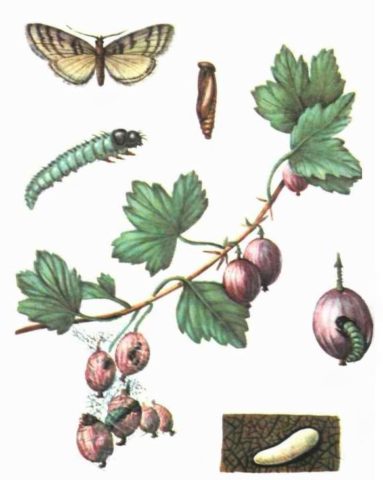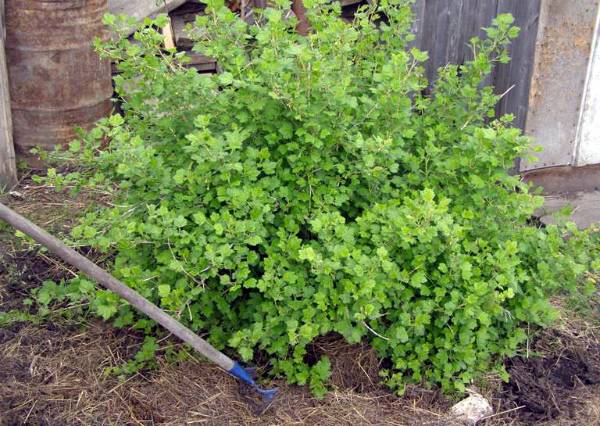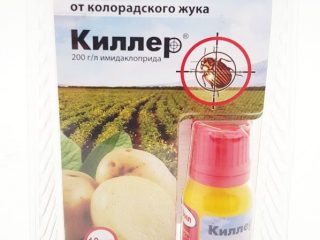Content
Many gardeners who grow gooseberries and other berry crops on their plots are faced with the need to eliminate damage to the bushes caused by various insects. The gooseberry moth is one of the most common pests and, if uncontrolled, can lead to a significant reduction in the quantitative and qualitative indicators of the crop.
What does a gooseberry moth look like?
A small gray moth-like butterfly with a wingspan of up to 3 cm and a length of no more than 1.5 cm. The front wings are dark gray in color, with light stripes and a brown spot in the center. The second pair of wings is fringed, lighter, with a dark-colored edging.
The flight activity of butterflies depends on the weather and air temperature levels. As a rule, this period coincides with the beginning of gooseberry flowering and lasts almost a month.Within a week after emergence, adult moths lay white, oval-shaped eggs 0.7 mm in size, first in the bud, then in the flowers, and later on the ovary. Each female moth is able to lay up to 200 eggs. The flight of moths in warm weather lasts several days, in cold weather it lasts 1–2 weeks. After 10 days, the eggs hatch into caterpillars 2 to 3 mm long with a small black head and 16 legs. Newborn caterpillars are white with a yellow tint, then, as they mature, they become gray-green, with clearly visible dark blurry stripes. The maximum length of their body is 9 - 15 mm.
The offspring of moths begin to gnaw en masse on the pulp and seeds of flowers and ovaries, enveloping them in cobwebs. There is only 1 caterpillar in one ovary, the rest occupy places in neighboring buds. The caterpillars actively feed and develop for about a month, after which they prepare for pupation. This period coincides with the full ripening of the berries. Having completed the development stage, in the 2nd - 3rd decade of June, future moth butterflies with the help of cobwebs descend from the gooseberry to the ground, go deeper by 5 - 7 cm and pupate.
Brown moth pupae with 8 curved spines develop up to 9 mm in length. They overwinter in cocoons made of gray-green cobwebs, 5-7 pieces each in the top layer of soil under debris and fallen leaves within a radius of no more than 40 cm from the gooseberry bushes. In spring, the pupae turn into moths.
The photo shows an adult gooseberry moth:
What harm does the moth cause to gooseberries?
The gooseberry moth is widespread in the central and northern parts of Russia and can destroy from 50 to 90% of the crop.
The main food of the caterpillars is seeds and berry pulp. In a short period, 1 caterpillar can gnaw 5 - 7 gooseberries. Spoiled fruits turn brown and dry out.
Signs of gooseberry infection
To determine the cause of spoilage of the berries and detect the gooseberry moth on the bushes, it is enough to carefully examine the branches of the bushes. Violation of the integrity of the berries, the presence of holes in the peel, entangling them in a web - all these signs indicate that the gooseberry has been exposed to butterfly pests. Every day the number of spoiled fruits will increase, and in the absence of timely protection measures, you can lose the entire harvest.
The gooseberry moth quickly covers new areas of the plant, creating entire cobwebby clumps, inside of which there can be up to 6 berries. Some may appear untouched, while others appear rotten or dried out. The gooseberry moth does not touch the shell of the berries, eating only their pulp and seeds.
Having stirred up the cobweb nest and crushed the berry, which seems undamaged, inside you can see a fairly long caterpillar, up to 1 cm in size. Gradually, the number of good fruits will be significantly reduced, and the caterpillars will leave the bushes, going down on the cobweb. This process can also be seen with the naked eye.
How to deal with gooseberry moth
Having discovered the presence of the gooseberry moth on the bushes, you should immediately take protective measures aimed at destroying the pest. The main common methods include:
- Folk – using various natural and plant components.
- Chemical - the most effective, but unsafe for the plants themselves and humans.Consists in the use of chemicals.
- Agrotechnical - a set of activities that every gardener can independently carry out on his own site.
When choosing the most suitable method for treating bushes against the effects of the gooseberry moth, it is necessary to take into account and take into account all the strengths and weaknesses of each method.
Folk remedies
For a long time, owners of garden plots have not only been breeding, growing and harvesting berries, but also improving known and common methods of combating gooseberry moth. Practical experience is passed on from generation to generation and includes the use of accessible, effective means:
- Mustard infusion. 100 g of dry mustard are diluted in a bucket of water, left for 2 days at room temperature, filtered and combined with water, twice the volume of the infusion.
- Pine needle extract. Pour 200 g of spruce or pine needles with two liters of hot water, cover and leave for a week, stirring daily. The finished infusion is filtered and diluted in a ratio of 1:10. To control pests, plants are sprayed once a week during the entire flowering period.
- Infusion from tomato tops. To treat gooseberries against moth, 1 kg of tomato is left to soak in a bucket of water for 24 hours. The filtered mixture is sprayed onto the bushes once a day.
- A solution of wood ash and soap. 1 kg of ash is infused in a bucket of water for 7 days. The liquid is filtered and soap is added so that the resulting infusion sticks to the leaves. Infected gooseberry bushes are sprayed during the formation of ovaries.
- Elderberry powder solution. Infuse 10 g of powder in 1 liter of water and filter after 48 hours.It is recommended to process gooseberries in the evening, during the period of greatest activity of butterflies - moths. To do this, 200 ml of concentrate is diluted in 800 ml of water before spraying.
- Infusion of chamomile. 100 g of dried chamomile flowers are poured into 10 liters of hot water. Leave for 2 days and treat the gooseberry bushes 4 days after the flowers have fully bloomed.
As an alternative, you can use tansy grass, yarrow, and onion.
- Tobacco decoction. 400 g of shag or tobacco dust is infused in 10 liters of water for 48 hours. Then dilute in the same amount of water. Spray during the flowering period once a week.
- On the advice of the famous breeder I.V. Michurin, the gooseberry moth, which has settled tightly on the bushes, can be scared away by sticking an elderberry branch into each one.
Regardless of the chosen method of combating moths, gooseberries should be processed early in the morning or in the evening to prevent the leaves from getting sunburned.
How to get rid of gooseberry moth using chemicals
If, when moth moths are discovered on gooseberries, all the measures taken to combat them did not give the desired result and it was not possible to defeat the pest, you will have to use more effective, but unsafe methods based on the use of chemicals.
The means of combating a strong degree of impact on pests include “Aktellik”, “Karbofos”, “Etafos”. This treatment will not only protect the gooseberries from the moth, but will also prevent the occurrence of a fungal disease - anthracnose. This disease is characterized by the appearance of small dark spots that merge over time.The disease can lead to almost complete bareness of bushes by the end of summer and a reduction in harvest. Spraying with chemical solutions is carried out after flowering is completed. If this year there is a massive infestation of bushes by butterflies, then next year it is recommended to treat the bushes before flowering begins.
Here are some more tips that can help in the fight against gooseberry moth:
- Treatment of branches with a 12% dust solution. After a week after spraying the branches, you should scatter about 50 g of dry dust under each gooseberry bush.
- The soil can be treated with hexachlorane. Poisoned mail will help in pest control and will lead to the death of butterflies crawling on it.
- During the period of bud formation, the branches are sprayed with the preparations “Kinmiks”, “Gardona”, “Iskra”, “Karate”, “Fufanon”. Insecticidal agents have a wide spectrum of action and effectively destroy the gooseberry moth at all stages of its development.
- After flowering is completed, treatment with biological preparations “Gomelin”, “Lepidocid”, “Bitoxibacillin”, “Agravertin” is recommended.
From the completion of treatment of gooseberry bushes with chemicals to the start of picking berries, a time interval of at least 1 month must be maintained.
If the invasion of gooseberry moths on the site has not yet become widespread, it is better to combat them using methods that are safe for human health and the environment.
Mechanical methods of combating gooseberry moth
One of the most effective ways to combat gooseberry moth, as the experience of gardeners shows, is to dig up the soil surrounding the berry bush. The work will require some physical effort, but the result will please you with its effectiveness. To protect the berries from the appearance of moths and destroy the pupae that have settled for the winter, it is necessary to hill up all the bushes at the base by 10 - 15 cm.
Moth moths will not be able to get out from under such a layer of soil. To achieve the best result, it is necessary to take a layer of soil of at least 5 cm, located between the rows, where the presence of moth pupae is unlikely. In autumn, after the leaves have fallen, it is also recommended to mulch the ground and soil around the bushes with peat or compost with a layer of 8–10 cm. The resulting mulch can be covered with film, roofing felt or mulch paper. The soil should remain in this state until spring. 2 weeks after the gooseberries have faded, the surface layer must be removed.
There are many simple, proven and accessible to every gardener ways to combat gooseberry moth using mechanical methods:
- Installing traps with fermented juice.
- Placement of electrical and light traps on the site.
- Planting tomatoes and red elderberries near gooseberry bushes will repel the moths.
- Watering shrubs with hot water in early spring before the snow melts.
- Laying roofing material near the base of the bushes - from the root to the end of the branches.The method is best used in late autumn, when the moth caterpillars have pupated for the winter. A densely laid layer will not allow gooseberry moths to crawl to the surface in the spring. To consolidate the results obtained, the procedure must be repeated in the second year.
How to protect gooseberries from moth
In order to prevent and control the pest, it is necessary to regularly walk around and inspect the bushes to detect moths on gooseberries and destroy the caterpillars and berries spoiled by them, entangled in cobwebs. This will help to take protective measures in time and protect the rest of the crop from the rapid spread of the gooseberry moth. It is also necessary to inspect other plants located in close proximity to the gooseberry plantings. Thus, the berry crops that the moth loves - currants or raspberries - can become a source of their appearance.
Natural factors and knowledge of the vital functions of moths will help gardeners in destroying their population. In dry, hot summer conditions, the moth larvae die before they have time to take refuge in the upper layers of the soil.
A parasitic fungus called pink muscardine develops in the spring when there is heavy rainfall and has a detrimental effect on the development of butterflies. Gardeners can also be helped in the fight against moth by various insects, for example, flies - tahini and ichneumon flies of the braconid family.
Trichogramma (pictured) are released onto gooseberry bushes during the period of egg laying by moths.Small insects damage the shell and parasitize the hatched caterpillars. The presence of ground beetles in the garden also reduces the number of gooseberry moths.
In addition, shrubs need to be provided with good lighting and air circulation. The bushes should not be allowed to thicken; gooseberries should be thinned and pruned in a timely manner. And with the onset of autumn, it is recommended to clean the soil near the bushes from debris and fallen leaves.
Conclusion
The gooseberry moth, despite its outwardly harmless appearance, when multiplied en masse, can destroy a significant portion of the gooseberry berry crop. There are several control methods to protect the area from the invasion of these pests. Each gardener will be able to choose the most suitable method of combating moth, based on financial and physical capabilities. But we should not forget that to obtain an environmentally friendly harvest, pesticides should be used as a last resort, giving preference to safe biological and folk remedies.

















